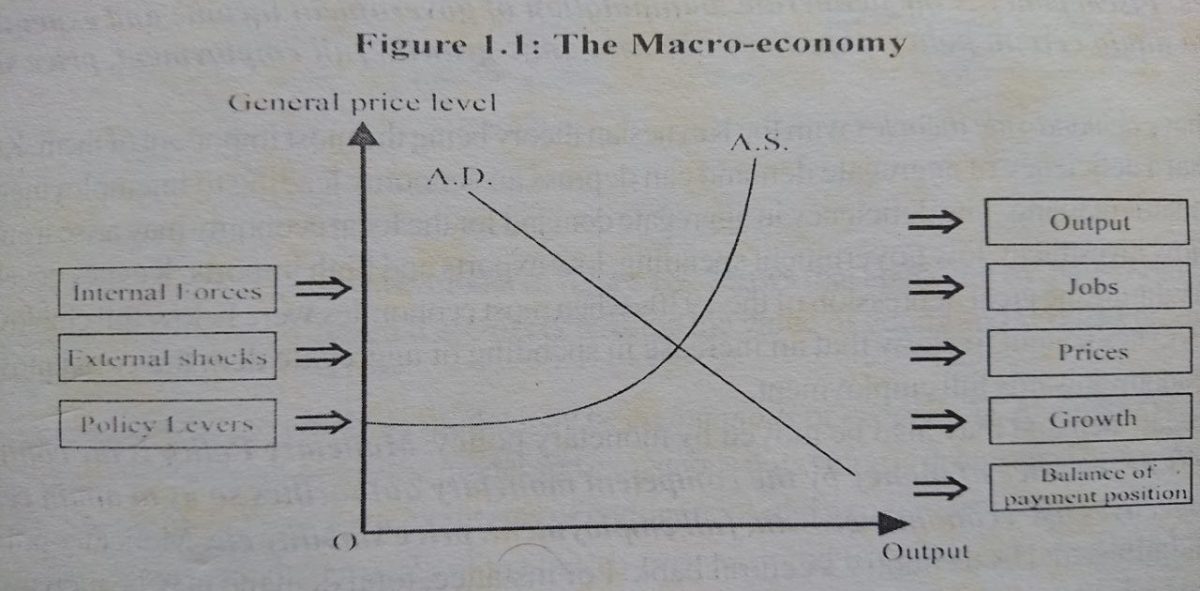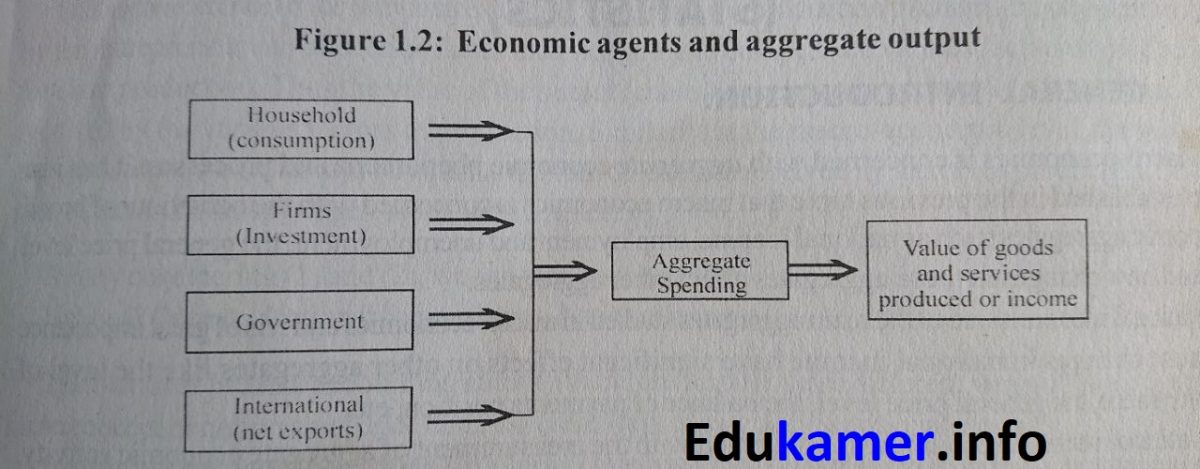In today’s lesson note destined for Advanced Level students, we will discuss some of the Main Concerns of Macroeconomics. Macroeconomics is basically concerned with aggregates like output. employment, etc. and how changes in these aggregates affect other aggregates.
Economic well-being is measured in terms of the volume of output produced, and the number of jobs created. price stability, a favourable balance of payments situation etc. These are economic outcomes, These outcomes result from the interplay of the forces of aggregate demand and aggregate supply. The extent to which aggregate demand and supply can be influenced would influence these outcomes.
Let us consider Figure 1.1 which illustrates a global or macro-view of the functioning of the macroeconomy.

On the left-hand side of figure 1.1, we have the various determinants of the macroeconomy. which influence average demand and aggregate supply to bring about the different outcomes on the right-hand side of figure 1.1.
CONCEPTS FOR REVIEW IN THIS TOPIC:
Macroeconomics
Keynesian revolution
Classical economists
Demand-side theories
Supply-side theories
Economic models
endogenous variables
Exogenous variablesThe determinants of macroeconomic performance
- Internal Forces: These include investment, population growth, spending behaviour, invention and innovation amongst others.
- External shocks: These include wars. trade disruptions, natural disasters, etc.
- Policy Levers: These include various aspects of monetary and fiscal policies as well as other policies.
The aggregate demand and aggregate supply curves summarise the market activity of the whole economy and result in outcomes in terms of output. jobs, prices, etc. There are two potential problems with macro-equilibrium.
1.) The price-output relationship at equilibrium may not satisfy the macroeconomic goals of the economy. For instance, there could be less than full employment or there could be inflation at equilibrium.
2.) Even if the macroeconomic equilibrium is desirable, it may not be stable. In order to get the appropriate macro-economic equilibrium with desirable outcomes, it may be necessary to:- a) Shift the aggregate demand curve. i.c to find and use the policy tools that stimulate or restrain total spending.
- b) Shift the aggregate supply curve. i.e. find and implement policies that reduce costs of Production increase productivity or otherwise bring about more output at every price level.
- c) Shift aggregate demand and aggregate supply simultaneously.
- d) Allow the economy to be adjusted by itself.
In effect, most macroeconomic controversies are based on the shape of the aggregate demand and aggregate supply curves and the potential to shift them so as to bring about desirable economic outcomes.
The major policies available to influence the demand side of markets are called fiscal and monetary policies. Fiscal policy is the deliberate manipulation of government income and expenditure so as to attain certain policy objectives like economic growth, full employment, price stability etc…
We have demand-side theories with the Keynesian theory being the most important of them. Keynes holds that a deficiency of aggregate demand can depress an economy leading to unemployment and low standards of living. The deficiency in aggregate demand for the local economy may arise from high savings and low investment. low government spending. low exports and high imports. Keynes developed his theory during the recent depression of the 1930s when most economies were below full employment output. Keynes sought to show that an increase in spending or aggregate demand could move the world economy towards full employment.
Aggregate demand may also be moved by monetary policy. Monetary Policy is the control of the supply or the price of money by the competent monetary authorities so as to attain certain policy objectives like economic growth, full employment, price stability etc. Monetary policy is usually administered by a country’s central bank. For instance, total demand may be increased by making more funds available to be borrowed so that interest rates fall thus enabling economic agents to have cheap money and hence increase their purchases of goods and services.
It may be necessary to influence the macro-economic outcomes of figure 1.1 above by Supply-side policies. These policies involve the use of tax rates, deregulation, and other mechanisms to increase the ability and willingness to produce goods and services. Supply-side policies are intended to cause rightward shifts in supply (increases) in many individual markets and hence in the global economy. For instance. if there is a reduction in the rates of personal income taxes, this may increase the amount of work that people wish to do and hence lead to an increase in aggregate supply in the economy. Supply-side policies are treated in topics 09 and 21 of this volume. The US government of Ronald Reagan implemented lots of supply-side policies with considerable success in the 1980s.
The economy is hardly ever allowed to be completely self-regulated as classical economists of extreme monetarists would have wished. We should however admit that excessive government! intervention in an economy may actually hamper or disturb desirable economic outcomes
Nevertheless, there is an equally great need for government to intervene in the economy so as to achieve specific outcomes which the unregulated market may hardly achieve.
The Main Concerns of Macroeconomics: Economic Models
Most of the issues alluded to above would be examined with the aid of economic models. A mode of individual or aggregate economic behaviour represents a simplification of real economic complexities. It does not attempt to capture all the relevant influences on behaviour or to mirror the complexities of the real-life economic situation it explains. For instance. in studying the level of aggregate output or income in an economy, it would be useful to divide the economy into the following spending sectors: Households, Firms, Government and International sectors. Once the spending behaviour of each sector is specified, the economist is able to predict the level of aggregate output. Figure 1.2. summarises the operation of this model.

The very simplified economic model of figure 1.2. shows that spending by households, firms, the government and the international sectors determine the value of goods and services produced or the level of income:
The variables in an economic model may be endogenous or exogenous. A variable is endogenous if its value is determined within the model and exogenous if its value is determined by forces outside the model.
As earlier suggested, our study of the macroeconomy and Economics in general basically boils down to studying various economic theories and models. We should, therefore, look forward to cheerfully embrace these theories and models even if they may have some little arithmetic or mathematics. The arithmetic is only intended to give some precision to the theories or models and we cannot afford to be less scientific in Economics in a growing scientific world.SOME QUESTIONS FOR REVIEW:
After reading this lesson notes, you should think now about how to tacle the following questions if asked;
1 ) Why do classical economists see the economy to be inherently stable?
2 ) What brought about the Keynesian revolution in the 1930s?
3 ) Account for the relative loss of faith in Keynesian economics in recent years. What is at the base of most macro-economic controversies?
4 ) What is the importance of the ceteris Paribus assumption in economic theory? 




